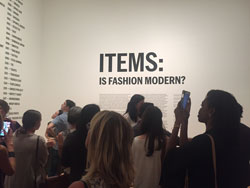 Attendees gather at the MoMA for a preview of
Attendees gather at the MoMA for a preview of
“Items: Is Fashion Modern?”Most of us assemble our outfits every day, but stop short at “Does this go together?” or “Do I look good in this?” and understandably don’t stop to think about the relationships we have with our ensembles let alone mull over their impact on a global, collective scale.
The Museum of Modern Art’s newest exhibition, “Items: Is Fashion Modern?” sets out to present these concepts to museumgoers and challenge them to think about the ways clothing and accessories are made, how they become pervasive symbols of their time and gain a deeper insight into the systemic complexity of fashion itself.
The exhibit which opens on Oct. 1, 2017 and runs until Jan. 28, 2018 is MoMA’s first exhibition dedicated to fashion design since 1944, and I previewed it earlier this week.
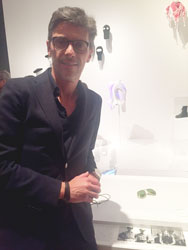 Luxottica’s Fabrizio Uguzzoni stands
Luxottica’s Fabrizio Uguzzoni stands
beside the display of the classic 1970s
Ray-Ban Aviator Sunglass style,
included among the iconic items
selected for the exhibit.“A powerful form of creative and personal expression that can be approached from multiple angles of study, fashion is unquestionably a form of design, with its pitch struck in negotiations between form and function, means and goals, automated technologies and craftsmanship, standardization and customization, universality and self-expression,” said Paola Antonelli, senior curator, department of architecture and design, director, research and development at MoMA.
Her commentary on the exhibition is posted here. She continued, “Like all physical and digital forms of design, it moves today on a spectrum ranging from post-industrial seriality (from pret-a-porter to fast fashion) to precious, handcrafted uniqueness (couture). As design, it exists in the service of others. In most cases, it is designed by a human being to dress others—sometimes many, many others—so that they can function in the world, in different arenas.”
The exhibit expands upon the conversation of the 1944 show by architect and curator, Bernard Rudofsky, “Are Clothes Modern,” as he sought to “prod museumgoers to reconsider their relationship with the clothes they wore.” Rudofsky’s initial question provides a “springboard (and foil) from which to consider the ways in which fashion is designed, manufactured, marketed, distributed, worn and disposed of today.”
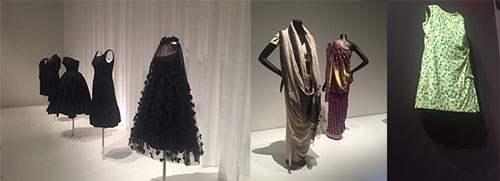
A row of iconic little black dresses (l) were on display (from a range of fashion designers)
as were traditional saris (center) and one of Lilly Pulitzer’s dress designs at MoMA.
Each item transported attendees to a moment in history, politics, a popular trend, identity or a cultural way of life—the crisscross of fashion and function. “Items: Is Fashion Modern?” showcases a wide, diverse range of accessories and clothing from A to Z. They included Chanel No. 5 perfume, classic Levi’s 501 jeans, a strand of white pearls, Champion hooded sweatshirts, Hanes T-shirt (complete with pop sayings and images) along with tracksuits, penny loafers, dashikis, berets, Capezio ballet flats and more.
“In this exhibition, garments created for the benefit of many coexist with those made for the delight of a few. What they have in common is their influence on the world over the past 100 years,” MoMA said.
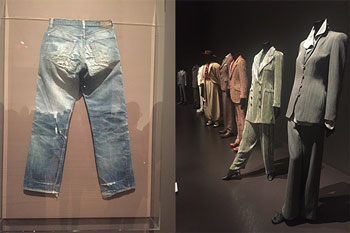
Levi’s 501 jeans, along with a row of suits and
silhouettes that were popular through various
time periods over the last century.
While the Ray-Ban aviator was the sole piece of eyewear showcased, these topics of origin, purpose, craft and relation to culture that these broad range of items pose can easily be applied to the history and influence of the optical industry as a whole. Perhaps MoMA’s effort could be inspiration for another future exhibit about eyewear in its own right?
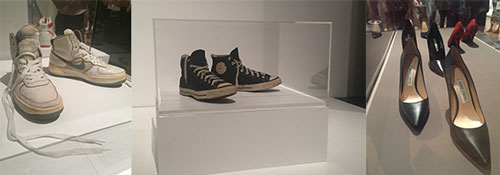
On display were Nike high top sneakers, Converse Chuck Taylors
and multiple high heel shoes including Jimmy Choo.
The purpose of “Items” is to get people thinking about the impact that these pieces have had and still do have on all of us. It’s a call to look at fashion with a more curious eye—examining it with awareness and respect.

Classic polo shirt designs from Lacoste, Fred Perry and Ralph Lauren were showcased
along with famous sports jerseys and the well-known Breton striped top.
So, is fashion modern?